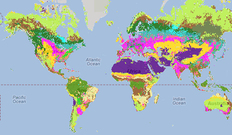Part 2: Albedo, Seasons, and Land Cover
Guiding Question:
How does albedo change
over the seasons in different
land cover classes?
Definitions:

- Land Cover Class = a broad classification system of land cover (the physical material on the surface of the Earth). For more information on the MODIS land cover classification system see: http://www.igbp.net.
- MODIS = The MODerate resolution Imaging Spectroradiometer is a scientific instrument launched by NASA that captures data in 36 spectral bands. It images the entire Earth every 1 to 2 days. For more information see: http://modis.gsfc.nasa.gov.
Materials:
- Computer with access to the Internet
- Science Notebook
- Land Cover Class Slideshow

- Land
Cover Class Definitions

- Changes in Seasonal Albedo with Land Cover Class document
Estimated Time:
- 1.5 hours
What to do and how to do it:
- INTRODUCTION: Use the Land Cover Class Slideshow or Definitions to introduce the concept of land cover classes, and explore the specific classes that are used by the MODIS instrument (for a general description of what satellites do, see NASA's What is a Satellite resource). Provide a brief background of the MODIS instrument. Revisit the importance of satellite data (long-term measurements and global coverage).
-
- Navigate to Carbon Mapper using the instructions on the Changes in Seasonal Albedo with Land Cover Class handout.
- Instructor provides a brief tour of the Carbon Mapper (See
Carbon Mapper Features document in side bar)
- Students continue to follow instructions on the Changes in Seasonal Albedo
with Land Cover Class handout to find seasonal
albedo for locations with different land cover classes. Note:
Handouts instruct students to use data from 2013. If you
decide to have students use data from other years, be
aware that there may be missing data at the lat/lon
locations in the handout. If this is the case, have
students choose a nearby lat/lon with complete data that
is still in the same land cover class.
- WRAP-UP: Answer any questions students have regarding the activity or concepts.
Assessment
- Use the Checklist for Student Work, or your own rubric, to assess the quality of student work.
- Have students either informally report out to the class on the overall results/trends of their study (orally or using chart paper, the smartboard, etc.) or create a formal report. For suggestions, rubrics, and examples of formal reports, see the GLOBE Carbon Cycle Communicating Findings page.
